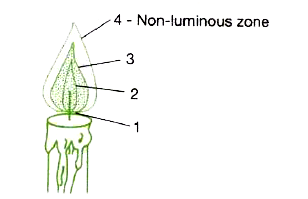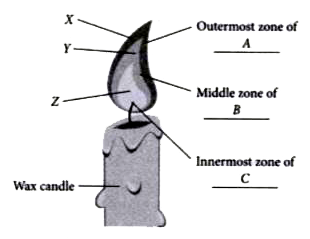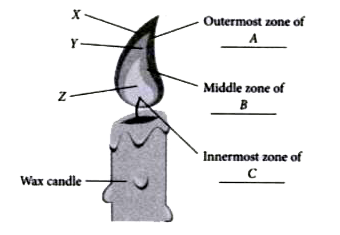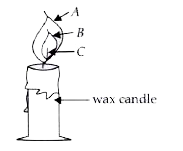There are following zones of a flame :-
Two
Three
Four
No any zone
The correct Answer is:B
Step by step video, text & image solution for There are following zones of a flame :- by Chemistry experts to help you in doubts & scoring excellent marks in Class 8 exams.
Topper's Solved these Questions
- BOOK - PEARSON IIT JEE FOUNDATIONCHAPTER - COMBUSTION AND FLAME EXERCISE - CLASSROOM CORNER Very Short Answer Type Questions (Comprehenssion-Based Questions)8videos
COMBUSTION AND FLAME
- BOOK - PEARSON IIT JEE FOUNDATIONCHAPTER - COMBUSTION AND FLAME EXERCISE - CLASSROOM CORNER Very Short Answer Type Questions (Subjective Type Questions)12videos
COMBUSTION AND FLAME
- BOOK - PEARSON IIT JEE FOUNDATIONCHAPTER - COMBUSTION AND FLAME EXERCISE - HOTS-HIGHER ORDER THINKING SKILLS8videos
COMBUSTION AND FLAME
- BOOK - PEARSON IIT JEE FOUNDATIONCHAPTER - COAL AND PETROLEUMEXERCISE - COMPETITION CORNER48videos
COAL AND PETROLEUM
- BOOK - PEARSON IIT JEE FOUNDATIONCHAPTER - Language of Chemistry and Transformation of SubstancesEXERCISE - Concept Application Concept Application Level - 310videos
Language of Chemistry and Transformation of Substances
Similar Questions
In order to understand the structure of a flame, light a wax candle and watch its flame. Carefully note the different coloured zones in the flame. Starting from the base of the flame, a flame has three zones. Check the below figure and try to answer the following question

Why the flame in the outermost zone is blue in colour?View SolutionA flame is the visible gaseous part of a fire. It is a zone of combustion of gaseous substances accompanied by evolution of heat and light. All substances do not burn with a flame. Only those substances that vaporise during burning produce flame. A candle flame is taken to study the various zones of a flame.

Which zone of a candle flame is the zone of no combustion?View Solution
Knowledge Check
- Question 1 - Select One
Which of the following does not form a flame?
Abunsen burnerBcandleCcharcoalDkerosene lamp - Question 2 - Select One
In which of the following zones of atmosphere ozone layer is present ?
ATroposphereBStratosphereCMesosphereDExosphere - Question 3 - Select One
Rearrange the following zones as seen in the root in vertical section and choose the correct option.
A.Root hair zone , B.Zone of meristems
C.Root cap zone , D.Zone of maturation
E.Zone of elongationAC,B,E,A,DBA,B,C,D,ECD,E,A,C,BDE,D,C,B,A
A flame is the visible gaseous part of a fire. It is a zone of combustion of gaseous substances accompanied by evolution of heat and light. All substances do not burn with a flame. Only those substances that vaporise during burning produce flame. A candle flame is taken to study the various zones of a flame.

Different zones of a candle flame are marked by the letters (A), (B) and (C).
Which of the following statements are correct?
(I) (B) is the hottest part of the flame.
(II) (C) is moderately hot.
(III) (A) is the hottest part of the flame.
(IV) (A) is moderately hot whereas (C) is the coldest part.
(V) (C) is the luminous zone.
(VI) (B) is the luminous zone.
(VII) (A) is the dark zone.View SolutionA flame is the visible gaseous part of a fire. It is a zone of combustion of gaseous substances accompanied by evolution of heat and light. All substances do not burn with a flame. Only those substances that vaporise during burning produce flame. A candle flame is taken to study the various zones of a flame.

(A), (B) and (C) are respectively.View SolutionA flame is the visible gaseous part of a fire. It is a zone of combustion of gaseous substances accompanied by evolution of heat and light. All substances do not burn with a flame. Only those substances that vaporise during burning produce flame. A candle flame is taken to study the various zones of a flame.

Arrange X, Y and Z in increasing order of temperature.View SolutionThe different zones of a candle flame are marked by the letters A, B and C.

Which of the following is correct?View SolutionMatch the points mentioned in column 'A' to the points mentioned in column B with regard to the zones of a flame and its characteristics.
A B1. Dark inner zonea. Hottest part (no Carbon)2. Blue zoneb. Partial decomposition3. Luminous zonec. Unburnt vapours of wax4. Non-luminous zoned. Complete combustionView Solution
